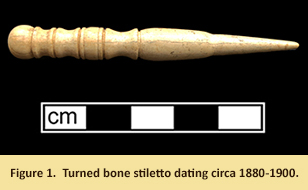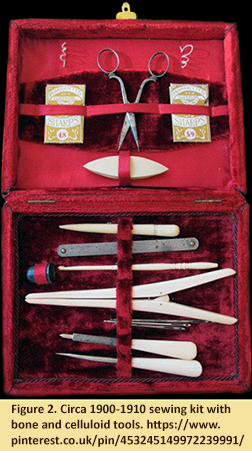Curator's Choice 2018
A Bone Sewing Stiletto
June 2018
By Patricia Samford,
MAC Lab Director
 This modest little artifact was hidden, along with several stoneware marbles, under a set of outdoor steps in downtown Baltimore sometime in the last quarter of the nineteenth century. There it remained, unnoticed and forgotten, until archaeologists discovered this little cache of artifacts when they were conducting excavations in advance of the building of the Baltimore City Life Museum (18BC68).
This modest little artifact was hidden, along with several stoneware marbles, under a set of outdoor steps in downtown Baltimore sometime in the last quarter of the nineteenth century. There it remained, unnoticed and forgotten, until archaeologists discovered this little cache of artifacts when they were conducting excavations in advance of the building of the Baltimore City Life Museum (18BC68).
 Measuring 2.5 inches in length, this lathe turned bone sewing stiletto or awl, was used to punch holes through coarse materials like felt, leather or canvas (Sullivan 2004) or to force open the weave of a fabric to create an eyelet or buttonhole. Because the weave of the fabric remained uncut, it resisted tearing. A stiletto was also useful for removing basting stitches. Sewing stilettos were an important component of needlework and sewing boxes in the Victorian period.
Measuring 2.5 inches in length, this lathe turned bone sewing stiletto or awl, was used to punch holes through coarse materials like felt, leather or canvas (Sullivan 2004) or to force open the weave of a fabric to create an eyelet or buttonhole. Because the weave of the fabric remained uncut, it resisted tearing. A stiletto was also useful for removing basting stitches. Sewing stilettos were an important component of needlework and sewing boxes in the Victorian period.
Examples of stilettos identical to this Baltimore artifact date circa 1880 to 1900 (Thompson 1997). This dating coincides perfectly with the blue and brown glazed stoneware marbles placed with the awl under the steps of the house at 26 Albemarle Street. Benningtons, as these marbles are popularly called, are not seen in U. S. archaeological assemblages until around 1890 (Gartley and Carskadden 1998).
Why these artifacts were hidden together under these steps remains a mystery. In 1876, the property at 26 Albemarle Street, with its three-story brick house, was acquired by Theodore Heinrich Ladensack. The house remained in his ownership until 1909, when he transferred the property to Theresa Ladensack and Laura Beck (Scott 1989:43). Perhaps they were hidden under the steps by children in the household.
| References |
| Gartley, Richard and Jeff Carskadden |
| 1998 |
Colonial Period and Early 19th-Century Children’s Toy Marbles; History and Identification for the Archaeologist and Collector. The Muskingum Valley Archaeological Survey, Zanesville, Ohio. |
|
| Scott, Deborah M. |
| 1989 |
An Archival Investigation of the Archaeological Resources Associated with the Baltimore History Center of the Baltimore City Life Museums, Baltimore, Maryland. Baltimore Center for Urban Archaeology Research Series 30. |
|
| Sullivan, Kay |
| 2004 |
Needlework Tools and Accessories; A Dutch Tradition. Antique Collector�s Club, Woodbridge, Suffolk. |
|
| Thompson, Helen Lester |
| 1997 |
Sewing Tools and Trinkets. Collector Books, Paducah, Kentucky. |
|